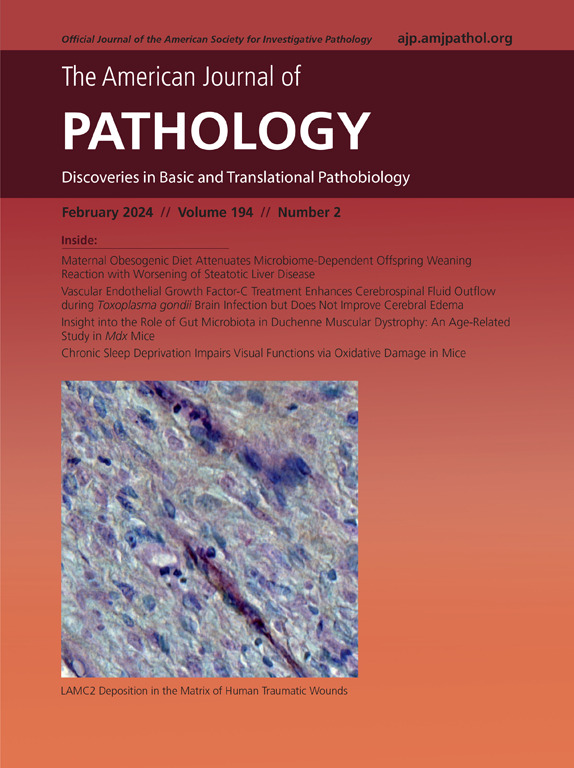Computationally Enabled Polychromatic Polarized Imaging Enables Mapping of Matrix Architectures that Promote Pancreatic Ductal Adenocarcinoma Dissemination
IF 3.6
2区 医学
Q1 PATHOLOGY
引用次数: 0
Abstract
Pancreatic ductal adenocarcinoma (PDA) is a highly metastatic and lethal disease. In PDA, extracellular matrix (ECM) architectures, known as tumor-associated collagen signatures (TACSs), regulate invasion and metastatic spread in both early dissemination and late-stage disease. As such, TACS has been suggested as a biomarker to aid in pathologic assessment. However, despite its significance, approaches to quantitatively capture these ECM patterns currently require advanced optical systems with signaling processing analysis. Herein, an expansion of polychromatic polarized microscopy (PPM) with inherent angular information coupled with machine learning and computational pixel-wise analysis of TACS was used to accurately capture TACS architectures in hematoxylin and eosin–stained histology sections directly through PPM contrast. Moreover, PPM facilitated identification of transitions to dissemination architectures (ie, transitions from sequestration through expansion to dissemination from both pancreatic intraepithelial neoplasias and throughout PDA). Lastly, PPM evaluation of architectures in liver metastases, the most common metastatic site for PDA, demonstrated TACS-mediated focal and local invasion as well as identification of unique patterns anchoring aligned fibers into normal-adjacent tumor, suggesting that these patterns may be precursors to metastasis expansion and local spread from micrometastatic lesions. Combined, these findings demonstrate that PPM coupled to computational platforms is a powerful tool for analyzing ECM architecture that can be used to advance cancer microenvironment studies and provide clinically relevant diagnostic information.
计算支持的多色偏振成像可以绘制促进胰腺导管腺癌扩散的基质结构。
胰腺导管腺癌(PDA)是一种极具转移性和致死率的疾病。在PDA中,被称为肿瘤相关胶原标记(TACS)的细胞外基质(ECM)结构调节早期传播和晚期疾病的侵袭和转移扩散。因此,TACS被认为是一种有助于病理评估的生物标志物。然而,尽管其意义重大,定量捕获这些电子对抗模式的方法目前需要具有信号处理分析的先进光学系统。在这里,我们提出了一个扩展的多色偏振显微镜(PPM)与固有的角度信息耦合到机器学习和计算像素分析的TACS。使用该平台,我们能够通过PPM对比直接准确地捕获H&E染色组织学切片中的TACS结构。此外,PPM有助于识别向传播架构的过渡,即从隔离到扩展到从PanINs和整个PDA传播的过渡。最后,对肝转移灶(PDA最常见的转移部位)的结构进行PPM评估,表明tacs介导的局灶性和局部侵袭,以及将排列纤维锚定到正常邻近肿瘤的独特模式的鉴定,表明这些模式可能是微转移灶转移扩张和局部扩散的前兆。综上所述,这些发现表明,PPM与计算平台相结合是分析ECM架构的强大工具,可用于推进癌症微环境研究并提供临床相关诊断信息。
本文章由计算机程序翻译,如有差异,请以英文原文为准。
求助全文
约1分钟内获得全文
求助全文
来源期刊
CiteScore
11.40
自引率
0.00%
发文量
178
审稿时长
30 days
期刊介绍:
The American Journal of Pathology, official journal of the American Society for Investigative Pathology, published by Elsevier, Inc., seeks high-quality original research reports, reviews, and commentaries related to the molecular and cellular basis of disease. The editors will consider basic, translational, and clinical investigations that directly address mechanisms of pathogenesis or provide a foundation for future mechanistic inquiries. Examples of such foundational investigations include data mining, identification of biomarkers, molecular pathology, and discovery research. Foundational studies that incorporate deep learning and artificial intelligence are also welcome. High priority is given to studies of human disease and relevant experimental models using molecular, cellular, and organismal approaches.

 求助内容:
求助内容: 应助结果提醒方式:
应助结果提醒方式:


